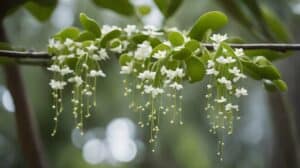Moth orchids, also known as Phalaenopsis, are a popular choice among orchid enthusiasts due to their stunning blooms and relatively easy care.
However, mastering the art of Phalaenopsis care can be challenging for beginners.
With the right knowledge and techniques, anyone can achieve beautiful blooms and healthy plants.

In this article, readers will discover the secrets to achieving moth orchid mastery.
From proper watering and light conditions to fertilization and pest control, this guide will cover everything needed to keep Phalaenopsis plants thriving.
Whether you’re a beginner or an experienced orchid grower, these tips and tricks will help take your moth orchid care to the next level.
So, let’s dive in and explore the world of Phalaenopsis orchids!
Understanding Phalaenopsis Orchids
Species Overview
Phalaenopsis, also known as moth orchids, are a popular genus of orchids that are native to Southeast Asia, including the Philippines, Indonesia, and Malaysia.
They are known for their large, showy flowers that bloom in a variety of colors, including white, pink, yellow, and purple.
There are over 60 species of Phalaenopsis orchids, with many hybrids and cultivars available.
These orchids are popular among growers and collectors due to their ease of care and their stunning blooms.
Natural Habitat and History
Phalaenopsis orchids are epiphytes, which means they grow on other plants, such as trees, without harming them.
In their natural habitat, these orchids can be found growing in the warm, humid forests of Southeast Asia.
These orchids have a long history, with some species being used for medicinal purposes and others being cultivated for their beauty.
The first Phalaenopsis orchid was discovered in the early 19th century by a French botanist named Louis-Marie Aubert du Petit-Thouars.
Since then, these orchids have become popular around the world, with many new hybrids and cultivars being developed each year.
Overall, understanding the natural habitat and history of Phalaenopsis orchids can help growers better care for these stunning plants and appreciate their beauty.
Essential Care Techniques

Watering Requirements
Phalaenopsis orchids require consistent moisture, but they should never be allowed to sit in standing water.
Overwatering can lead to root rot and other issues. When watering, it is important to thoroughly saturate the potting mix and then allow it to drain completely.
This can be done by placing the pot in a sink or tub and allowing water to run through the potting mix for several minutes.
Light and Temperature
Phalaenopsis orchids prefer bright, indirect light.
They should be placed near a window that receives filtered light, but they should not be exposed to direct sunlight.
The ideal temperature range for these orchids is between 60 and 85 degrees Fahrenheit. They should be kept away from cold drafts and extreme heat sources.
Soil and Repotting
Phalaenopsis orchids require a well-draining potting mix that is specifically designed for orchids.
They should be repotted every two to three years or when the potting mix begins to break down.
When repotting, it is important to gently remove the plant from its current pot and carefully trim any dead or damaged roots before planting it in fresh potting mix.
Fertilization Strategies
Phalaenopsis orchids should be fertilized regularly during the growing season (spring and summer) with a balanced, water-soluble fertilizer.
It is important to follow the manufacturer’s instructions carefully and avoid over-fertilizing, as this can lead to salt buildup in the potting mix.
During the dormant season (fall and winter), fertilization should be reduced or stopped altogether.
Bloom Boosting Secrets

Phalaenopsis orchids, also known as Moth Orchids, are popular due to their beautiful blooms and ease of care.
However, to get the most stunning blooms, there are a few secrets to keep in mind.
Pruning and Maintenance
Regular pruning is essential to keep Phalaenopsis orchids healthy and blooming.
Dead or yellowing leaves and flowers should be removed promptly to prevent the spread of disease and to encourage new growth.
It’s also important to keep the plant clean and free of debris.
Wiping the leaves with a damp cloth or using a gentle spray of water can help remove dust and pests.
Encouraging Reblooming
To encourage reblooming, Phalaenopsis orchids need a period of cool temperatures and reduced watering.
After the plant has finished blooming, move it to a cooler location with indirect sunlight and reduce watering to once a week.
After a few weeks, new growth should appear, and the plant can be moved back to its original location with regular watering.
With the right care, Phalaenopsis orchids can rebloom multiple times a year.
Dealing with Pests and Diseases
Phalaenopsis orchids are susceptible to pests and diseases, but with proper care, they can be prevented or treated.
Common pests include spider mites, scale, and mealybugs.
Regular inspection and treatment with insecticidal soap or neem oil can help keep these pests at bay.
Diseases such as root rot and fungal infections can be prevented by avoiding overwatering and providing good air circulation.
If these issues do arise, treatment with a fungicide may be necessary.
By following these bloom-boosting secrets, Phalaenopsis orchid owners can enjoy stunning blooms year-round.
Display and Aesthetic Tips

Phalaenopsis orchids are prized for their stunning blooms and make a beautiful addition to any home or office.
Here are some tips for displaying and enhancing the aesthetics of your moth orchids:
Potting and Presentation
Proper potting and presentation can make a big difference in the overall look of your orchid.
Choose a pot that complements the colors and style of your orchid. Clear plastic pots are a popular choice as they allow for easy monitoring of the roots.
When potting, use a well-draining orchid mix and ensure that the roots are not buried too deep.
Leave the top of the roots exposed to allow for air circulation.
A layer of decorative moss or bark can be added on top of the soil for a more polished look.
To enhance the presentation of your orchid, consider placing it in a decorative container or on a stand.
This will elevate the orchid and draw attention to its beauty.
Companion Plants and Decor
Pairing your orchid with the right companion plants and decor can create a stunning display.
Choose plants that have similar light and water requirements to your orchid, such as ferns or bromeliads.
This will create a cohesive and visually pleasing arrangement.
Decorative elements such as stones, shells, or figurines can also be added to enhance the aesthetics of your display.
Be mindful not to overcrowd the area around your orchid, as this can detract from its natural beauty.
By following these tips for potting, presentation, and companion plants, you can create a beautiful and eye-catching display for your moth orchid.
Frequently Asked Questions

What are the best practices for caring for a Phalaenopsis orchid as a beginner?
For beginners, it is important to understand that Phalaenopsis orchids prefer bright, indirect light and a consistent temperature range of 65-80°F.
Watering once a week, or when the potting mix is dry to the touch, is recommended.
Fertilizing every 2-3 weeks with a balanced orchid fertilizer is also important for healthy growth.
How should I care for my Phalaenopsis orchid once it has finished blooming?
After your Phalaenopsis orchid has finished blooming, it is important to trim the spike just above the second or third node to encourage new growth.
Continue to care for your orchid as usual, but reduce watering frequency slightly until new growth appears.
What are the secrets to keeping orchid flowers vibrant and healthy?
To keep orchid flowers vibrant and healthy, it is important to provide adequate light, water, and nutrients.
Avoid overwatering and make sure to use a well-draining potting mix.
Regularly fertilizing with a balanced orchid fertilizer and maintaining a consistent temperature range can also help promote healthy blooms.
Can you guide me through the process of inducing a new spike in my orchid?
To induce a new spike in your orchid, it is important to provide a consistent temperature range of 65-80°F and bright, indirect light.
Fertilizing every 2-3 weeks with a high-phosphorus orchid fertilizer can also help encourage new growth.
Once a new spike appears, continue to care for your orchid as usual.
What is the ideal indoor environment for nurturing Phalaenopsis orchids?
The ideal indoor environment for nurturing Phalaenopsis orchids is a bright, humid room with a consistent temperature range of 65-80°F.
Avoid placing your orchid in direct sunlight or near drafts.
Using a humidifier or placing a tray of water near the orchid can also help maintain a humid environment.
What techniques can I use to ensure my orchids bloom throughout the year?
To ensure your orchids bloom throughout the year, it is important to provide adequate light, water, and nutrients.
Fertilizing every 2-3 weeks with a balanced orchid fertilizer can help promote healthy growth and blooms.
Additionally, providing a consistent temperature range and avoiding drastic temperature changes can also help encourage blooming.














